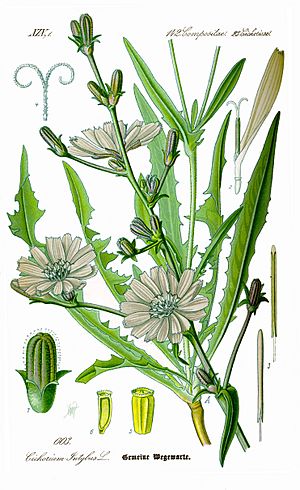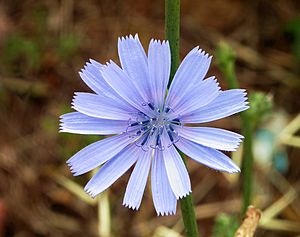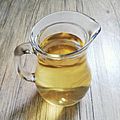Chicory facts for kids
Quick facts for kids Common chicory |
|
|---|---|
 |
|
| 1885 illustration | |
 |
|
| Scientific classification | |
| Genus: |
Cichorium
|
| Species: |
intybus
|
Common chicory (Cichorium intybus) is a plant with pretty blue flowers. It's a type of herb that lives for many years. It belongs to the dandelion family. Sometimes, its flowers can be white or pink.
People use chicory in many ways. It can be a food plant or even a coffee substitute. Farmers grow different types for salad leaves or for their roots. The roots are often baked and ground up. This powder can be used instead of coffee. It can also be added to other foods.
Chicory roots contain something called inulin. Inulin is used in food factories. It can make foods sweeter. It also adds fiber, which is good for your digestion.
Chicory also grows as a food for farm animals. You can often see it growing wild on roadsides in Europe. It has now spread to North America, China, and Australia.
Sometimes, people confuse common chicory with curly endive. Curly endive (Cichorium endivia) is a close relative. Both plants are called "chicory" in some places.
Contents
What is Chicory?
Chicory is a plant that grows from a strong root. It has a slightly woody stem. The plant can grow back year after year. This means it is a perennial plant. Its scientific name is Cichorium intybus.
Where Does Chicory Grow?
Chicory is originally from Europe. It grows well in many different places. You can often spot it along roads and in fields. It has spread to many other parts of the world. This includes places like North America, China, and Australia. It is now a common plant in these areas.
How is Chicory Used?
Chicory is a very useful plant. People use it for food, drinks, and even for animals. Its different parts can be used in various ways.
Chicory as Food
Many types of chicory are grown for eating.
- Salad Leaves: Some varieties have fresh leaves. These leaves are used in salads. They can add a slightly bitter taste.
- Chicons: These are the blanched buds of the plant. Blanching means growing them in the dark. This makes them pale and less bitter. They are popular in some European dishes.
- Roots: The roots are a very important part. They can be baked and ground. This powder is often mixed with coffee. It gives coffee a different flavor. Sometimes, it is used as a full coffee substitute.
Inulin from Chicory
In the 21st century, a special part of chicory became popular. This is inulin. Inulin is taken from the chicory root. It is a type of carbohydrate.
- Sweetener: Inulin can be used to sweeten foods. It is a natural sweetener.
- Dietary Fiber: It is also a good source of dietary fiber. Fiber helps your body digest food. It is often added to healthy snacks and drinks.
Chicory for Animals
Chicory is not just for people. Farmers also grow it for their livestock. Animals like cows and sheep can eat it. It provides good nutrition for them. It is a healthy forage crop.
Images for kids
See also
 In Spanish: Achicoria común para niños
In Spanish: Achicoria común para niños






